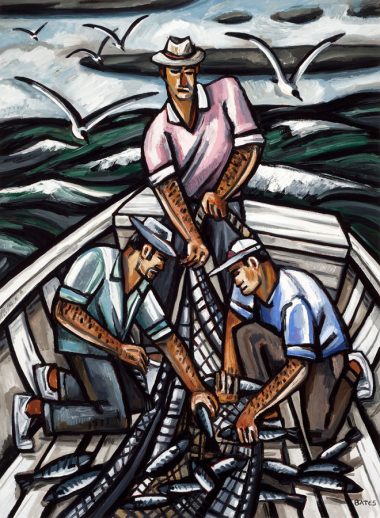by D. Eric Bookhardt, Gambit
D. Eric Bookhardt on images of coastal Louisiana
 Dallas artist David Bates may be the finest painter his hometown has ever produced, but when it comes to his favorite sport, he heads to Louisiana and the remote extremities of Plaquemines Parish. While the paintings in this Down Highway 23 series reflect the everyday lives of fishermen, they were inspired by a trip he made in 2010, when instead of the usual scenes of shrimpers, oystermen and boats laden with the day’s catch, he encountered a coastal dystopia defined by reporters, politicians, tar balls, oil slicks and clean up crews in hazmat suits. Evidence of the BP oil disaster was everywhere in a coastal landscape transformed into something nightmarish, but amid the chaos he began to spot the familiar faces of those who derived their living from those waters. What he saw in them was not defeat but the same resilience that had faced many hurricanes and come back for more.
Dallas artist David Bates may be the finest painter his hometown has ever produced, but when it comes to his favorite sport, he heads to Louisiana and the remote extremities of Plaquemines Parish. While the paintings in this Down Highway 23 series reflect the everyday lives of fishermen, they were inspired by a trip he made in 2010, when instead of the usual scenes of shrimpers, oystermen and boats laden with the day’s catch, he encountered a coastal dystopia defined by reporters, politicians, tar balls, oil slicks and clean up crews in hazmat suits. Evidence of the BP oil disaster was everywhere in a coastal landscape transformed into something nightmarish, but amid the chaos he began to spot the familiar faces of those who derived their living from those waters. What he saw in them was not defeat but the same resilience that had faced many hurricanes and come back for more.
Net Fishermen (pictured) is emblematic. Painted in a style that recalls the stoic strength of Diego Rivera’s peasants, or Lynd Ward’s starkly monumental images of 1930s American workers, it’s a view of three men in a boat culling fish from a net — but the hovering gulls and stormy sea transform a prosaic scene into something far more iconic. Similar sensibilities are seen in Bait Fishing II, a view of two guys working a seine net, and Cleaning Fish, Venice Louisiana II, both timeless scenes of the sort that have been reenacted repeatedly since the Stone Age. Both also are defined by the stoic resolve seen in the faces of the figures. But his Refinery — Port Sulphur — Night is a hellish vision that might have inspired William Blake’s “dark Satanic Mills,” a line in a short poem that prefaces Milton, a Poem. All are rendered in vigorous, expressionistic slashes of pigment delivered with the bold, Zen-like economy of a karate master. Here Bates clearly defines the clash between technological depredation and the timeless nature-based lifestyle that he renders with such mythopoetic resonance.
